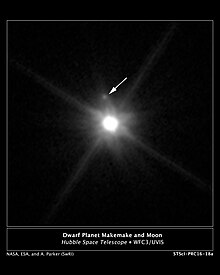S/2015 (136472) 1

S/2015 (136472) 1, nicknamed MK 2 by the discovery team,[1] is the only known moon of the dwarf planet Makemake. It is estimated to be 100 miles (160 km) in diameter and is located some 13,000 miles (21,000 km) from Makemake.[2] Observations leading to the discovery of the moon occurred in April 2015, using the Hubble Telescope's Wide Field Camera 3 and its discovery was announced on April 26, 2016.[1]
A preliminary examination of the imagery suggests that S/2015 has a reflectivity similar to charcoal, making it an extremely dark object. This is somewhat surprising because Makemake is the second-brightest known object in the Kuiper Belt. One theory to explain this is the satellite's gravity may not be strong enough to prevent bright but volatile ices from being lost to space when it is heated by the distant Sun. Alex Parker, the leader of the team that performed the analysis of the Hubble images at the Southwest Research Institute, said that the moon's orbit appears to be aligned edge-on to Earth-based observatories. This would make it much more difficult to detect because it would be lost in Makemake's glare much of the time and, along with its dark surface, would contribute to previous surveys failing to observe it.[3]
Citations
- ^ a b "HubbleSite - NewsCenter - Hubble Discovers Moon Orbiting the Dwarf Planet Makemake (04/26/2016) - The Full Story". hubblesite.org. Retrieved 26 April 2016.
- ^ "Hubble Spies A Moon Orbiting A Distant Dwarf Planet". Popular Science. Retrieved 26 April 2016.
- ^ Mike Wall (26 April 2016). "Distant Dwarf Planet Makemake Has Its Own Moon". Space.com. Retrieved 26 April 2016.
